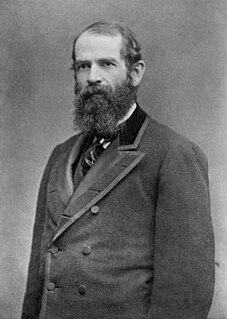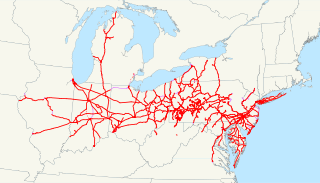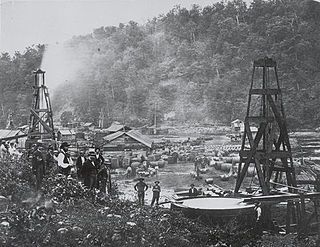Related Research Articles
Standard Oil Co. was an American oil-producing, transporting, refining, marketing company. Established in 1870, by John D. Rockefeller and Henry Flagler as a corporation in Ohio, it was the largest oil refiner in the world of its time. Its history as one of the world's first and largest multinational corporations ended in 1911, when the U.S. Supreme Court ruled, in a landmark case, that Standard Oil was an illegal monopoly.

Jason Gould was an American railroad magnate and financial speculator who is generally identified as one of the robber barons of the Gilded Age. His sharp and often unscrupulous business practices made him one of the wealthiest men of the late nineteenth century. A highly controversial and unpopular figure during his life, Gould is widely regarded as one of the great villains of his era, with few defenders then or now.

John Davison Rockefeller Sr. was an American business magnate and philanthropist. He is widely considered the wealthiest American of all time, and the richest person in modern history.

The Pennsylvania Railroad was an American Class I railroad that was established in 1846 and was headquartered in Philadelphia, Pennsylvania. It was so named because it was established in the Commonwealth of Pennsylvania.

Henry Morrison Flagler was an American industrialist and a founder of Standard Oil, first based in Ohio. He was also a key figure in the development of the Atlantic coast of Florida and founder of what became the Florida East Coast Railway, much of which he built through convict leasing. He is known as the father of Miami and Palm Beach, Florida.

Henry Huttleston Rogers was an American industrialist and financier. A descendant of the original Mayflower Pilgrims, he made his fortune in the oil refining business, becoming a leader at Standard Oil. He also played a major role in numerous corporations and business enterprises in the gas industry, copper, and railroads.
The South Improvement Company was a short lived Pennsylvania corporation founded in late 1871 which existed until the state of Pennsylvania suspended its charter on April 2, 1872. It was created by major railroad and oil interests, and was widely seen as part of John D. Rockefeller's early efforts to organize and control the oil industry in the United States under Standard Oil. The company's purpose was to end a rate war with the rail trunk lines by dividing oil traffic more evenly between the Pennsylvania Railroad, the Erie Railroad, and the New York Central railroads. The second purpose of the company was to limit production of refined oil - the country had a daily refining capacity of 40,000 barrels and a market for only 16,000. Although the company never shipped any oil, the South Improvement Company scheme caused widespread attention to be focused on the relationships between big railroads and big businesses which wanted and demanded favorable treatment. In what would become known as the Cleveland Massacre, John D. Rockefeller and Henry Flagler bought eighteen refineries, only one of which wasn't located in Cleveland over a month's time between mid-February and mid-March 1872.

The Western Maryland Railway was an American Class I railroad (1852–1983) which operated in Maryland, West Virginia, and Pennsylvania. It was primarily a coal hauling and freight railroad, with a small passenger train operation.

Amasa Stone, Jr. was an American industrialist who is best remembered for having created a regional railroad empire centered in the U.S. state of Ohio from 1860 to 1883. He gained fame in New England in the 1840s for building hundreds of bridges, most of them Howe truss bridges. After moving into railroad construction in 1848, Stone moved to Cleveland, Ohio, in 1850. Within four years he was a director of the Cleveland, Columbus and Cincinnati Railroad and the Cleveland, Painesville and Ashtabula Railroad. The latter merged with the Lake Shore and Michigan Southern Railway, of which Stone was appointed director. Stone was also a director or president of numerous railroads in Ohio, New York, Pennsylvania, Indiana, Illinois, Iowa, and Michigan.

John Dustin Archbold was an American businessman and one of the United States' earliest oil refiners. His small oil company was bought out by John D. Rockefeller's Standard Oil Company. Archbold rose rapidly at Standard Oil, handling many of the complex secret negotiations over the years. By 1882, he was Rockefeller's closest associate, and typically acted as the company's primary spokesman. Rockefeller, after 1896, left business matters to Archbold while he pursued his philanthropy; as vice president, Archbold effectively ran Standard Oil until his death in 1916. Inspired by Rockefeller's policies, Archbold's main goals were stabilization, efficiency, and minimizing waste in refining and distributing petroleum products. The company was broken up by the Supreme Court in 1911 into 34 smaller operations, Archbold became president of the largest one, Standard Oil of New Jersey.
Rockefeller, Andrews & Flagler was a business concern formed in 1867 in Cleveland, Ohio which was a predecessor of the Standard Oil Company. The principals and namesakes were John D. Rockefeller, William Rockefeller, Samuel Andrews, and Henry M. Flagler. Flagler’s step-brother Stephen V. Harkness made substantial investments, but was a silent partner and did not take an active role in running the business but he was actually the second largest stockholder next to JD Rockefeller.

Samuel Andrews (1836–1904) was a chemist and inventor. Born in England, he immigrated to the United States before the American Civil War and settled in Cleveland, Ohio. He is best known as a partner in the oil refining firm of Rockefeller, Andrews & Flagler, the major predecessor company of the Standard Oil corporate empire. When the first unit was formed in 1870, Andrews owned 16.67% of Standard Oil stock. He sold his stock early on in 1874 and while he was wealthy, he did not participate in the level of wealth generation that the other founders did.

Pittsburgh, surrounded by rivers and hills, has a unique transportation infrastructure that includes roads, tunnels, bridges, railroads, inclines, bike paths, and stairways.

The Allegheny Valley Railroad is a class III railroad that operates in Western Pennsylvania, and is owned by Carload Express, Inc.
The Gould transcontinental system was a system of railroads assembled by George Jay Gould I and the Fuller Syndicate in the early 1900s. This was Gould's attempt to fulfill a goal of his late father, financier Jay Gould. Due to financial troubles following the Panic of 1907, the system was never completed as a fully transcontinental line.

The oil rush in America started in Titusville, Pennsylvania, in the Oil Creek Valley when Edwin L. Drake struck "rock oil" there in 1859. Titusville and other towns on the shores of Oil Creek expanded rapidly as oil wells and refineries shot up across the region. Oil quickly became one of the most valuable commodities in the United States and railroads expanded into Western Pennsylvania to ship petroleum to the rest of the country.
Simon Sterne was a United States lawyer and economist.
The Empire Transportation Company was a multimodal freight transportation company founded and operated by Joseph D. Potts in 1865. It owned a small fleet of boats on the Great Lakes which collected grain and produce which were then delivered to Erie, Pennsylvania. It owned 5,000 railroad cars, 1,500 of which were tank cars devoted to carrying oil. It also owned 520 miles of oil pipelines. By the mid-1870s, it hauled about 3,000,000 barrels of oil annually, of which about two-thirds came from independent oil refiners. The company was a subsidiary of the Pennsylvania Railroad and it was very profitable. In 1876 the company paid a 10 percent dividend ($400,000) on stock worth $4,000,000.
The Hepburn Committee was created in 1879 by an act of the New York State Legislature. A. Barton Hepburn was directed by the State Legislature to investigate the railroads' practice of giving rebates within the state. Merchants without ties to the oil industry had pressed for the hearings. Prior to the committee's investigation, few knew of the size of Standard Oil's control and influence on seemingly unaffiliated oil refineries and pipelines - Hawke (1980) cites that only a dozen or so within Standard Oil knew the extent of company operations. The committee counsel, Simon Sterne, questioned representatives from the Erie Railroad and the New York Central Railroad and discovered that at least half of their long-haul traffic granted rebates, and that much of this traffic came from Standard Oil. The committee then shifted focus to Standard Oil's operations. John Dustin Archbold, as president of Acme Oil Company, denied that Acme was associated with Standard Oil. He then admitted to being a director of Standard Oil. The committee's final report scolded the railroads for their rebate policies and cited Standard Oil as an example. This scolding was largely moot to Standard Oil's interests since long-distance oil pipelines were now their preferred method of transportation.
The Pithole Valley Railway was an ephemeral short line railroad in Venango County, Pennsylvania, constructed as a result of the Pennsylvania oil rush. The railroad was originally constructed in 1865 between Oil City, Pennsylvania, a local oil transportation hub, and the boomtown of Pithole, Pennsylvania. Constructed under the charter of the Clarion Land and Improvement Company, it was informally known as the Oil City and Pithole Branch Railroad. Although it was generally supported by the broad gauge Atlantic and Great Western Railway, it was built to standard gauge. Conflict with the Warren and Franklin Railway over the right-of-way along the Allegheny River led to a lawsuit which, in 1866, declared that the Oil City and Pithole had no right to operate along the river from Oleopolis, Pennsylvania to Oil City. That part of the line was sold to the Warren and Franklin, leaving the Oil City and Pithole with a 7-mile (10 km) line running north from Oleopolis to Pithole along Pithole Creek.